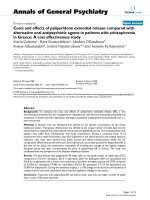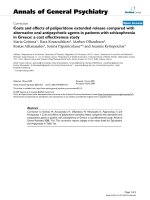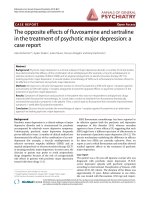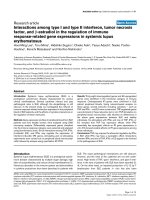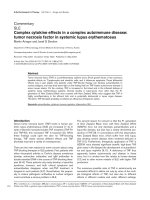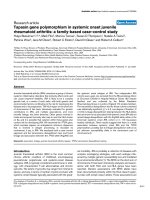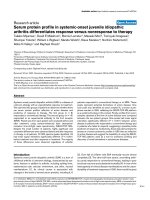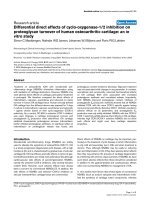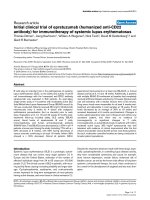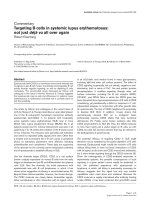Báo cáo y học: "Complex cytokine effects in a complex autoimmune disease: tumor necrosis factor in systemic lupus erythematosus" potx
Bạn đang xem bản rút gọn của tài liệu. Xem và tải ngay bản đầy đủ của tài liệu tại đây (226.01 KB, 6 trang )
172
IFN = interferon; IL = interleukin; MRL/lpr = murine lupus; NF = nuclear factor; NZB/W = F1 generation of New Zealand Black with New Zealand
White mice; SLE = systemic lupus erythematosus; TNF = tumor necrosis factor; TNF-R, tumor necrosis factor receptor.
Arthritis Research & Therapy Vol 5 No 4 Aringer and Smolen
Introduction
Serum tumor necrosis factor (TNF) levels in human sys-
temic lupus erythematosus (SLE) are increased [1–4]. In
spite of likewise increased soluble TNF receptors (TNF-R1
and TNF-R2), this increased TNF is bioactive [5]. While
these findings could open the door for TNF-blocking
therapy, TNF exerts several different effects and TNF
blockade may have a variety of consequences.
There are two main reasons for some concern about using
TNF blocking therapies in SLE patients. First, patients with
either rheumatoid arthritis or Crohn’s disease sometimes
develop antinuclear antibodies and IgM antibodies to
double-stranded DNA in the course of TNF-blocking thera-
pies [6–8]. These patients only rarely develop a lupus-like
syndrome, however, and both clinical symptoms and
autoantibodies disappear when anti-TNF treatment is
stopped in such patients [6,7]. Nevertheless, the propen-
sity to induce pathogenic antibodies to nuclear antigens
could constitute a serious problem in SLE.
The second reason for concern is that the F1 generation
of New Zealand Black mice with New Zealand White
(NZB/W) mice not only develops autoantibodies and a
lupus-like disease, but also has a clearly diminished pro-
duction of TNF [9]. In concordance with this observation,
New Zealand Black mice, which suffer from mild lupus,
also develop severe disease when rendered deficient in
TNF [10]. Furthermore, therapeutic application of TNF in
NZB/W mice showed significant benefit: high-dose TNF
given early in life delayed the development of autoantibod-
ies and lupus nephritis [9,11]. A deficiency of TNF thus
apparently fosters autoimmunity and disease in these
mice, but it is unclear how this relates to human disease
[12] and to other murine models of SLE with higher TNF
production.
The numerous possible roles of TNF in autoimmunity are
somewhat difficult to define not only by virtue of the multi-
ple biological effects of TNF, but also due to different
effects in different models and under different settings.
Commentary
SLE
Complex cytokine effects in a complex autoimmune disease:
tumor necrosis factor in systemic lupus erythematosus
Martin Aringer and Josef S Smolen
Department of Rheumatology, Internal Medicine III, University of Vienna, Austria
Corresponding author: Josef S Smolen (e-mail: )
Received: 7 Mar 2003 Accepted: 16 Apr 2003 Published: 14 May 2003
Arthritis Res Ther 2003, 5:172-177 (DOI 10.1186/ar770)
© 2003 BioMed Central Ltd (Print ISSN 1478-6354; Online ISSN 1478-6362)
Abstract
Tumor necrosis factor (TNF) is a proinflammatory cytokine and a B-cell growth factor. It has numerous
possible effects on T lymphocytes and dendritic cells, and it influences apoptosis. These differential
effects may in part explain why patients under TNF-blocker therapy can develop autoantibodies to
nuclear antigens, and may shed some light on the finding that low TNF fosters autoimmune disease in
some mouse strains. On the contrary, TNF is increased in the blood and in the inflamed kidneys of
systemic lupus erythematosus patients. Several studies in lupus-prone mice other than the F1
generation of New Zealand Black mice crossed with New Zealand White mice suggest that TNF is
highly proinflammatory in the efferent limb and is potentially detrimental in lupus organ disease.
Therefore, TNF blockade probably constitutes an efficacious therapeutic option.
Keywords: autoantibodies, cytokines, immune regulation, inflammation, SLE
173
Available online />However, although it is undisputed that this cytokine is
importantly involved in the context of autoimmunity, TNF
may indeed play more than one role [13–17]. In fact, many
functions of TNF are well defined, and we shall try to
discuss the different possible effects that TNF may have
on the pathogenesis of SLE.
Lymphoid organogenesis
Both membrane-bound TNF and secreted TNF are impor-
tant in the development of secondary lymphoid organ
structures, such as in lymph nodes, in the spleen and in
Peyer’s patches. Deficiency of TNF results in the absence
of germinal centers and in the absence of follicular den-
dritic cells. In particular, TNF cooperates with lymphotoxin
in secondary lymphoid tissue development and also medi-
ates signals for primary B-cell follicle generation [18–20].
While membrane-bound TNF confers the major structure
of secondary lymphoid organs, soluble TNF appears to be
involved in the generation of primary B-cell follicles [21].
Low levels of TNF may thus be associated with aberrant
B-cell responses [22].
Furthermore, TNF influences T-cell receptor signaling, and
TNF deficiency could also contribute to aberrant immune
reactivities through this additional pathway early on in
development and/or in the course of disease induction
[23]. The level of TNF expression both in its membrane-
associated form as well as in its soluble form thus con-
tributes importantly to the development of T cells, of B cells
and of dendritic cells (see later), and to the interactions
between these cells, and it may constitute one important
determinant of the type and level of immune responses.
Immune regulation
TNF exerts a wide variety of relevant immunoregulatory
functions on a variety of cells of the innate and adaptive
immune system. TNF is a growth factor for B lymphocytes,
and B lymphocytes are able to produce significant
amounts of TNF in an autocrine loop [24–26]. It is of inter-
est that this autocrine TNF production is induced by liga-
tion of CD40, a possible therapeutic target in SLE
[27–29], and is prevented by cyclosporin A, another ther-
apeutic agent for SLE [30]. Moreover, stimulation of
murine lupus (MRL/lpr) B cells by membrane-bound TNF
via their TNF-R2 provides a signal that overcomes the lack
of CD40 ligand (CD154) otherwise necessary for the pro-
duction of (auto)antibodies [31]. TNF may also exert a sig-
nificant influence on B cells by virtue of its capacity to
induce IL-6 [32]. The effects of IL-6 on multiple aspects of
B-cell development and activation as well as on SLE have
been well established [33]. IL-6 may also affect B cells via
T helper type 1 and T helper type 2 cells, the differentia-
tion of which IL-6 is also able to influence [34].
The potential of TNF to modify T-cell receptor signaling
has already been briefly mentioned. Interestingly, short-
term stimulation of activated T lymphocytes with TNF
results in further activation and proliferation [35–37].
Moreover, TNF stimulation leads to increased production
of IFN-γ [35], a cytokine with a clear-cut pathological role
in SLE [38–40].
In addition, chronic TNF exposure induces a reversible
loss of the surface T-cell receptor complex, and thus T-cell
hyporesponsiveness [41,42], but still allows for IL-2-medi-
ated proliferation. Since similar effects in rheumatoid
arthritis patients are readily reversed by anti-TNF therapy
[42], this normalization of T-cell hyporesponsiveness in
patients treated with TNF-blocking agents may also influ-
ence the induction of autoantibodies.
TNF also constitutes an activating cytokine and a matura-
tion factor of dendritic cells, which are essential in immune
regulation [43] and have also been implicated in auto-
immunity in general, and SLE in particular [44,45]. The
numbers of both myeloid and plasmacytoid dendritic cells
are reduced in the peripheral blood of SLE patients
[46,47]. These dendritic cell counts (or numbers) nega-
tively correlate with the patients’ soluble TNF-R2 levels
[46], which in turn correlate with TNF levels [2].
These findings together suggest that dendritic cells have
been matured by TNF and hence are found in lymphoid
organs rather than in the peripheral blood. On the con-
trary, IFN-α produced by lymphoid dendritic cells is
another important maturation factor for dendritic cells and
is thought to be involved in SLE pathogenesis [48].
However, TNF is able to inhibit the production of IFN-α
[49].
It is interesting that aged NZB/W mice behave differently,
in that they have increased numbers of circulating den-
dritic cells that can be matured by TNF [50]. This is proba-
bly due to the decreased systemic TNF production
described in NZB/W mice [9].
Apoptosis
The connection of TNF to cell death is already indicated
by its name. Indeed, the pro-apoptotic properties of the
cytokine, mediated mainly via TNF-R1 but possibly also via
TNF-R2, are well established [51–54]. By virtue of also
being able to activate anti-apoptotic pathways, and NF-κB
in particular, however, TNF can also inhibit apoptosis by
inducing a variety of anti-apoptotic molecules, such as
inhibitor of apoptosis, TNF-receptor associated factor, and
FLICE-like inhibitory protein [52–57]. Rheumatoid arthritis
synovial cells are just one example where TNF appears to
use such pathways to block Fas-mediated programmed
cell death [58,59]. In concordance with these findings,
induction of a stress response, which acts mostly via the
same signal transduction molecules as TNF, inhibits apop-
tosis [60].
174
Arthritis Research & Therapy Vol 5 No 4 Aringer and Smolen
Therefore, while lymphocytes of SLE patients die when
stimulated with high concentrations of TNF in vitro and
while serum TNF apparently is associated with the
increased in vitro lymphocyte apoptosis rate typical of SLE
[5], the in vivo role of TNF in this respect is not clear. In
fact, the observation of decreased apoptosis rates upon
addition of autologous plasma [5] rather suggests that the
propensity to undergo apoptosis in vitro may be due to
cytokine withdrawal afflicting in vivo activated cells [61].
Theoretically, an abrupt fall in bioactive TNF, as induced
by therapeutic TNF blockade, could thus lead to increased
Fas-mediated apoptosis. The subsequent exposure of the
immune system to more apoptotic material might then be
involved in inducing the aforementioned occurrence of
antibodies to nuclear antigens during TNF-blocking
therapy [6,7].
However, the notion that TNF can counteract Fas may also
be important in another regard. Given that in several mouse
strains mutations of Fas (lpr) or FasL (gld) cause severe
lupus-like disease by preventing FasL-induced apoptosis
[62,63], protection against Fas-induced apoptosis by TNF
may foster autoimmunity. Along these lines, TNF is indeed
necessary for sustaining the gld phenotype [64].
Inflammation
We have so far concentrated on aspects of TNF in the
afferent limb of the immune response (Fig. 1, upper part),
which suggest that TNF may promote a derangement of
immune regulation and be one factor potentially responsi-
ble for autoantibody induction. However, TNF is the most
important proinflammatory cytokine and a harbinger of
tissue destruction. In fact, in contrast to the complex role
of TNF in apoptosis and in immune regulation, its powerful
proinflammatory effects are unequivocal and have been
numerously reviewed [65].
In this regard, murine and human data on systemic lupus
arrive at the same conclusions. First, MRL/lpr mice have
high TNF in their serum as well as in their nephritic
kidneys, and both serum and renal TNF are correlated with
disease activity [66–68]. Also, anti-TNF therapy in
MRL/lpr mice [69,70], in motheaten mice [71] and in
C3H.SW mice [72] is beneficial. Moreover, even in
NZB/W mice, TNF application only delays and does not
prevent death from lupus [9]. Finally, even NZB/W
kidneys contain remarkably high amounts of TNF once
glomerulonephritis is established, and low dosages of TNF
administered in late NZB/W disease accelerate renal
damage [73,74].
All these data suggest that TNF is pivotally involved in the
tissue destruction observed in lupus organ disease. These
conclusions are further supported by observations that
macrophages are induced to produce high levels of TNF
by immune complexes [75]. Since murine lupus like
human SLE constitutes an immune complex-mediated
disease and since large amounts of immune complexes
are deposited in the glomeruli, it is highly unlikely that the
TNF expressed in renal tissue confers protective effects. It
rather portends what TNF expression in different tissues is
usually for: inflammation and consecutive tissue injury.
As in experimental lupus, TNF is highly expressed in
glomeruli in all forms of lupus nephritis [76–79], and the
degree of TNF expression correlates with renal inflamma-
tory activity [79], as measured by a histological activity
index. This correlation again suggests involvement of TNF
in the inflammatory and destructive process of the
disease. These data are further supported by the finding
that infliximab significantly reduced proteinuria, one of the
hallmarks of active lupus nephritis, in two patients treated
with this TNF blocker for a short period of time [79].
Figure 1
In the afferent limb of the (auto)immune response, tumor necrosis
factor (TNF) acts as a growth factor for B cells and may promote
dendritic cell (DC) maturation, but leads to T-cell hyporesponsiveness
and to the expression of anti-apoptotic molecules. Its inhibition by TNF-
blocking agents here could influence the immune response in several
ways. First, by better activation of T cells, including help for B cells and
influences in the T helper type 1/T helper type 2 cell balance (via IL-6).
Second, by reduced TNF effects (but increased IFN-α effects) on DCs,
and thus a divergence in DC maturation and activation steps. Finally,
by effects of B-cell activation via interference with B-cell proliferation
and (IL-6-mediated) class switching. All these changes could modulate
autoimmunity, particularly when paralleled by effects on apoptosis
(induction or inhibition). In the efferent limb, TNF is induced by immune
complexes (IC), and promotes inflammation and secondary tissue
destruction; liberation of autoantigens during necrosis could fuel
autoimmunity. TNF blockade therefore rapidly reduces TNF-induced
inflammation, but may also block immunomodulatory and anti-apoptotic
activities of TNF. Taken together, TNF blockade can interfere in a
beneficial way with tissue destruction, but in the afferent limb it may in
part foster autoimmunity. Ag, antigen; Ab, antibodies; M0,
monocytes/macrophages; T, T cells; B, B cells.
175
However, longer term follow up and careful observation of
potential adverse events (which were not seen hitherto)
are mandatory. All these data together indicate that TNF
plays a detrimental proinflammatory role in SLE organ
involvement (Fig. 1, lower part).
Conclusion
Understanding how the immune system integrates the
pleiotropic properties of TNF is a challenge, particularly so
in diseases like SLE. TNF is both a proinflammatory
cytokine and an immunoregulatory cytokine. TNF has dif-
ferential effects on B cells, on T cells and on dendritic
cells as well as on the process of programmed cell death.
These complex properties may explain why TNF blockade
can induce increases in antinuclear antibodies and at the
same time rapidly reduce inflammation and prevent inflam-
mation-induced damage, also observed in SLE patients.
These properties also explain why TNF deficiency may
foster systemic autoimmunity under some circumstances,
as seen in the NZB/W mice, but why lupus autoantibodies
also occur in mice with increased TNF [80].
TNF is therefore a cytokine with two roles in SLE: its capac-
ity as a prime immune regulator, and its capacity as a proin-
flammatory mediator. In the afferent limb of the
immunoinflammatory response, with its role in lymphoid
organ structure development and cellular interactions
therein, as well as its influence on B cells, on T cells and on
dendritic cells, TNF can modulate an autoimmune response;
blocking TNF therefore may or may not be wise (Fig. 1). In
the efferent limb of the response, TNF clearly induces
inflammation and local injury. With respect to the local
injury, blocking TNF should be highly beneficial (Fig. 1).
A critical view on all of these aspects will be necessary to
further increase our understanding of the role of TNF in
SLE. In the end, however, it is clinical trials that will put all
hypotheses to their most relevant tests.
Competing interests
JS is an occasional consultant for Centocor.
References
1. Maury CP, Teppo AM: Tumor necrosis factor in the serum of
patients with systemic lupus erythematosus. Arthritis Rheum
1989, 32:146-150.
2. Studnicka-Benke A, Steiner G, Petera P, Smolen JS: Tumour
necrosis factor alpha and its soluble receptors parallel clinical
disease and autoimmune activity in systemic lupus erythe-
matosus. Br J Rheumatol 1996, 35:1067-1074.
3. Gabay C, Cakir N, Moral F, Roux-Lombard P, Meyer O, Dayer JM,
Vischer T, Yazici H, Guerne PA: Circulating levels of tumor
necrosis factor soluble receptors in systemic lupus erythe-
matosus are significantly higher than in other rheumatic dis-
eases and correlate with disease activity. J Rheumatol 1997,
24:303-308.
4. Aringer M, Stummvoll GH, Steiner G, Koller M, Steiner CW,
Hofler E, Hiesberger H, Smolen JS, Graninger WB: Serum inter-
leukin-15 is elevated in systemic lupus erythematosus.
Rheumatology (Oxford) 2001, 40:876-881.
5. Aringer M, Feierl E, Steiner G, Stummvoll GH, Höfler E, Steiner
CW, Radda I, Smolen JS, Graninger WB: Increased bioactive
TNF in human systemic lupus erythematosus: associations
with cell death. Lupus 2002, 11:102-108.
6. Smolen J, Steiner G, Breedveld FC, Kalden JR, Lipsky PE, Maini
RN: Anti-TNF therapy and drug induced lupus-like syndrome
[abstract]. Ann Rheum Dis 1999, 58(suppl 1):217.
7. Charles PJ, Smeenk RJ, De Jong J, Feldmann M, Maini RN:
Assessment of antibodies to double-stranded DNA induced in
rheumatoid arthritis patients following treatment with inflix-
imab, a monoclonal antibody to tumor necrosis factor alpha:
findings in open-label and randomized placebo-controlled
trials. Arthritis Rheum 2000, 43:2383-2390.
8. Mohan AK, Edwards ET, Cote TR, Siegel JN, Braun MM: Drug-
induced systemic lupus erythematosus and TNF-alpha block-
ers [letter]. Lancet 2002, 360:646.
9. Jacob CO, McDevitt HO: Tumour necrosis factor-alpha in
murine autoimmune ‘lupus’ nephritis. Nature 1988, 331:356-
358.
10. Kontoyiannis D, Kollias G: Accelerated autoimmunity and lupus
nephritis in NZB mice with an engineered heterozygous defi-
ciency in tumor necrosis factor. Eur J Immunol 2000, 30:2038-
2047.
11. Gordon C, Ranges GE, Greenspan JS, Wofsy D: Chronic
therapy with recombinant tumor necrosis factor-alpha in
autoimmune NZB/NZW F1 mice. Clin Immunol Immunopathol
1989, 52:421-434.
12. Pisetsky DS: Tumor necrosis factor alpha blockers and the
induction of anti-DNA autoantibodies. Arthritis Rheum 2000,
43:2381-2382.
13. O’Shea JJ, Ma A, Lipsky P: Cytokines and autoimmunity. Nature
Rev Immunol 2002, 2:37-45.
14. Mageed RA, Isenberg DA: Tumour necrosis factor alpha in sys-
temic lupus erythematosus and anti-DNA autoantibody pro-
duction. Lupus 2002, 11:850-855.
15. Theofilopoulos AN, Lawson BR: Tumour necrosis factor and
other cytokines in murine lupus. Ann Rheum Dis 1999,
58(suppl 1):I49-I55.
16. Ettinger R, Mebius R, Browning JL, Michie SA, van Tuijl S, Kraal
G, van Ewijk W, McDevitt HO: Effects of tumor necrosis factor
and lymphotoxin on peripheral lymphoid tissue development.
Int Immunol 1998, 10:727-741.
17. Jacob CO: Tumor necrosis factor alpha in autoimmunity:
pretty girl or old witch? Immunol Today 1992, 13:122-125.
18. Wang Y, Wang J, Sun Y, Wu Q, Fu YX: Complementary effects
of TNF and lymphotoxin on the formation of germinal center
and follicular dendritic cells. J Immunol 2001, 166:330-337.
19. Ettinger R: The role of tumor necrosis factor and lymphotoxin
in lymphoid organ development. Curr Top Microbiol Immunol
2000, 251:203-210.
20. Fu YX, Chaplin DD: Development and maturation of secondary
lymphoid tissues. Annu Rev Immunol 1999, 17:399-433.
21. Ruuls SR, Hoek RM, Ngo VN, McNeil T, Lucian LA, Janatpour MJ,
Korner H, Scheerens H, Hessel EM, Cyster JG, McEvoy LM,
Sedgwick JD: Membrane-bound TNF supports secondary lym-
phoid organ structure but is subservient to secreted TNF in
driving autoimmune inflammation. Immunity 2001, 15:533-
543.
22. Vinuesa CG, Cook MC: The molecular basis of lymphoid archi-
tecture and B cell responses: implications for immunodefi-
ciency and immunopathology. Curr Mol Med 2001, 1:689-725.
23. McDevitt H, Munson S, Ettinger R, Wu A: Multiple roles for
tumor necrosis factor-alpha and lymphotoxin alpha/beta in
immunity and autoimmunity. Arthritis Res 2002, 4(suppl 3):
S141-S152.
24. Kehrl JH, Miller A, Fauci AS: Effect of tumor necrosis factor
alpha on mitogen-activated human B cells. J Exp Med 1987,
166:786-791.
25. Boussiotis VA, Nadler LM, Strominger JL, Goldfeld AE: Tumor
necrosis factor alpha is an autocrine growth factor for normal
human B cells. Proc Natl Acad Sci USA 1994, 91:7007-7011.
26. Rieckmann P, Tuscano JM, Kehrl JH: Tumor necrosis factor-
alpha (TNF-alpha) and interleukin-6 (IL-6) in B-lymphocyte
function. Methods 1997, 11:128-132.
27. Mohan C, Shi Y, Laman JD, Datta SK: Interaction between CD40
and its ligand gp39 in the development of murine lupus
nephritis. J Immunol 1995, 154:1470-1480.
Available online />176
28. Early GS, Zhao W, Burns CM: Anti-CD40 ligand antibody treat-
ment prevents the development of lupus-like nephritis in a
subset of New Zealand black x New Zealand white mice.
Response correlates with the absence of an anti-antibody
response. J Immunol 1996, 157:3159-3164.
29. Strand V: Monoclonal antibodies and other biologic therapies.
Lupus 2001, 10:216-221.
30. Griffiths B, Emery P: The treatment of lupus with cyclosporin A.
Lupus 2001, 10:165-170.
31. Fujii T, Okada M, Mimori T, Craft J: The transmembrane form of
TNF-alpha drives autoantibody production in the absence of
CD154: studies using MRL/Mp-Fas(lpr) mice. Clin Exp
Immunol 2002, 130:224-232.
32. Vanden Berghe W, Vermeulen L, De Wilde G, De Bosscher K,
Boone E, Haegeman G: Signal transduction by tumor necrosis
factor and gene regulation of the inflammatory cytokine inter-
leukin-6. Biochem Pharmacol 2000, 60:1185-1195.
33. Cross JT, Benton HP: The roles of interleukin-6 and inter-
leukin-10 in B cell hyperactivity in systemic lupus erythemato-
sus. Inflamm Res 1999, 48:255-261.
34. Diehl S, Rincon M: The two faces of IL-6 on Th1/Th2 differenti-
ation. Mol Immunol 2002, 39:531-536.
35. Scheurich P, Thoma B, Ucer U, Pfizenmaier K: Immunoregula-
tory activity of recombinant human tumor necrosis factor
(TNF)-alpha: induction of TNF receptors on human T cells and
TNF-alpha-mediated enhancement of T cell responses.
J Immunol 1987, 138:1786-1790.
36. Zucali JR, Elfenbein GJ, Barth KC, Dinarello CA: Effects of
human interleukin 1 and human tumor necrosis factor on
human T lymphocyte colony formation. J Clin Invest 1987, 80:
772-777.
37. Yokota S, Geppert TD, Lipsky PE: Enhancement of antigen- and
mitogen-induced human T lymphocyte proliferation by tumor
necrosis factor-alpha. J Immunol 1988, 140:531-536.
38. Machold KP, Smolen JS: Interferon-gamma induced exacerba-
tion of systemic lupus erythematosus. J Rheumatol 1990, 17:
831-832.
39. Graninger WB, Hassfeld W, Pesau BB, Machold KP, Zielinski
CC, Smolen JS: Induction of systemic lupus erythematosus by
interferon-gamma in a patient with rheumatoid arthritis.
J Rheumatol 1991, 18:1621-1622.
40. Theofilopoulos AN, Koundouris S, Kono DH, Lawson BR: The
role of IFN-gamma in systemic lupus erythematosus: a chal-
lenge to the Th1/Th2 paradigm in autoimmunity. Arthritis Res
2001, 3:136-141.
41. Isomaki P, Panesar M, Annenkov A, Clark JM, Foxwell BM, Cher-
najovsky Y, Cope AP: Prolonged exposure of T cells to TNF
down-regulates TCR zeta and expression of the TCR/CD3
complex at the cell surface. J Immunol 2001, 166:5495-5507.
42. Cope AP: Studies of T-cell activation in chronic inflammation.
Arthritis Res 2002, 4(suppl 3):S197-S211.
43. Menges M, Rossner S, Voigtlander C, Schindler H, Kukutsch NA,
Bogdan C, Erb K, Schuler G, Lutz MB: Repetitive injections of
dendritic cells matured with tumor necrosis factor alpha
induce antigen-specific protection of mice from autoimmu-
nity. J Exp Med 2002, 195:15-21.
44. Palucka AK, Banchereau J, Blanco P, Pascual V: The interplay of
dendritic cell subsets in systemic lupus erythematosus.
Immunol Cell Biol 2002, 80:484-488.
45. Drakesmith H, Chain B, Beverley P. How can dendritic cells
cause autoimmune disease? Immunol Today 2000, 21:214-
217.
46. Gill MA, Blanco P, Arce E, Pascual V, Banchereau J, Palucka AK:
Blood dendritic cells and DC-poietins in systemic lupus ery-
thematosus. Hum Immunol 2002, 63:1172-1180.
47. Scheinecker C, Zwolfer B, Koller M, Manner G, Smolen JS: Alter-
ations of dendritic cells in systemic lupus erythematosus:
phenotypic and functional deficiencies. Arthritis Rheum 2001,
44:856-865.
48. Blanco P, Palucka AK, Gill M, Pascual V, Banchereau J: Induction
of dendritic cell differentiation by IFN-alpha in systemic lupus
erythematosus. Science 2001, 294:1540-1543.
49. Gary-Gouy H, Lebon P, Dalloul AH: Type I interferon produc-
tion by plasmacytoid dendritic cells and monocytes is trig-
gered by viruses, but the level of production is controlled by
distinct cytokines. J Interferon Cytokine Res 2002, 22:653-
659.
50. Ishikawa S, Nagai S, Sato T, Akadegawa K, Yoneyama H, Zhang YY,
Onai N, Matsushima K: Increased circulating CD11b+CD11c+
dendritic cells (DC) in aged BWF1 mice which can be matured
by TNF-alpha into BLC/CXCL13-producing DC. Eur J Immunol
2002, 32:1881-1887.
51. Heller RA, Song K, Fan N, Chang DJ: The p70 tumor necrosis
factor receptor mediates cytotoxicity. Cell 1992, 70:47-56.
52. Chan FK, Siegel RM, Lenardo MJ: Signaling by the TNF recep-
tor superfamily and T cell homeostasis. Immunity 2000, 13:
419-422.
53. Karin M, Lin A: NF-kappaB at the crossroads of life and death.
Nat Immunol 2002, 3:221-227.
54. Chen G, Goeddel DV: TNF-R1 signaling: a beautiful pathway.
Science 2002, 296:1634-1635.
55. Wang CY, Mayo MW, Korneluk RG, Goeddel DV, Baldwin AS Jr:
NF-kappaB antiapoptosis: induction of TRAF1 and TRAF2 and
c-IAP1 and c-IAP2 to suppress caspase-8 activation. Science
1998, 281:1680-1683.
56. Micheau O, Lens S, Gaide O, Alevizopoulos K, Tschopp J: NF-
kappaB signals induce the expression of c-FLIP. Mol Cell Biol
2001, 21:5299-5305.
57. Wu XC, Asselin E, Tsang BK: Nuclear factor kappaB-mediated
induction of Flice-like inhibitory protein prevents tumor necro-
sis factor alpha-induced apoptosis in rat granulosa cells. Biol
Reprod 2002, 67:436-441.
58. Ohshima S, Mima T, Sasai M, Nishioka K, Shimizu M, Murata N,
Yoshikawa H, Nakanishi K, Suemura M, McCloskey RV, Kishimoto
T, Saeki Y: Tumour necrosis factor alpha (TNF-alpha) inter-
feres with Fas-mediated apoptotic cell death on rheumatoid
arthritis (RA) synovial cells: a possible mechanism of rheuma-
toid synovial hyperplasia and a clinical benefit of anti-TNF-
alpha therapy for RA. Cytokine 2000, 12:281-288.
59. Yamasaki S, Kawakami A, Nakashima T, Nakamura H, Kamachi M,
Honda S, Hirai Y, Hida A, Ida H, Migita K, Kawabe Y, Koji T,
Furuichi I, Aoyagi T, Eguchi K: Importance of NF-kappaB in
rheumatoid synovial tissues: in situ NF-kappaB expression
and in vitro study using cultured synovial cells. Ann Rheum
Dis 2001, 60:678-684.
60. Schett G, Steiner CW, Groger M, Winkler S, Graninger W,
Smolen J, Xu Q, Steiner G: Activation of Fas inhibits heat-
induced activation of HSF1 and up-regulation of hsp70.
FASEB J 1999, 13:833-842.
61. Graninger WB, Steiner CW, Graninger MT, Aringer M, Smolen
JS: Cytokine regulation of apoptosis and Bcl-2 expression in
lymphocytes of patients with systemic lupus erythematosus.
Cell Death Diff 2000, 7:966-972.
62. Watanabe-Fukunaga R, Brannan CI, Copeland NG, Jenkins NA,
Nagata S: Lymphoproliferation disorder in mice explained by
defects in Fas antigen that mediates apoptosis. Nature 1992,
356:314-317.
63. Takahashi T, Tanaka M, Brannan CI, Jenkins NA, Copeland NG,
Suda T, Nagata S: Generalized lymphoproliferative disease in
mice, caused by a point mutation in the Fas ligand. Cell 1994,
76:969-976.
64. Korner H, Cretney E, Wilhelm P, Kelly JM, Rollinghoff M, Sedg-
wick JD, Smyth MJ: Tumor necrosis factor sustains the gener-
alized lymphoproliferative disorder (gld) phenotype. J Exp
Med 2000, 191:89-96.
65. Andreakos ET, Foxwell BM, Brennan FM, Maini RN, Feldmann M:
Cytokines and anti-cytokine biologicals in autoimmunity:
present and future. Cytokine Growth Factor Rev 2002, 13:299-
313.
66. Boswell JM, Yui MA, Burt DW, Kelley VE: Increased tumor
necrosis factor and IL-1 beta gene expression in the kidneys
of mice with lupus nephritis. J Immunol 1988, 141:3050-3054.
67. Yokoyama H, Kreft B, Kelley VR: Biphasic increase in circulating
and renal TNF-alpha in MRL-lpr mice with differing regulatory
mechanisms. Kidney Int 1995, 47:122-130.
68. Tsai CY, Wu TH, Huang SF, Sun KH, Hsieh SC, Han SH, Yu HS,
Yu CL: Abnormal splenic and thymic IL-4 and TNF-alpha
expression in MRL-lpr/lpr mice. Scand J Immunol 1995, 41:
157-163.
69. Deguchi Y, Kishimoto S: Tumour necrosis factor/cachectin
plays a key role in autoimmune pulmonary inflammation in
lupus-prone mice. Clin Exp Immunol 1991, 85:392-395.
70. Edwards CK III, Zhou T, Zhang J, Baker TJ, De M, Long RE,
Borcherding DR, Bowlin TL, Bluethmann H, Mountz JD: Inhibition
Arthritis Research & Therapy Vol 5 No 4 Aringer and Smolen
177
of superantigen-induced proinflammatory cytokine produc-
tion and inflammatory arthritis in MRL-lpr/lpr mice by a tran-
scriptional inhibitor of TNF-alpha. J Immunol 1996, 157:
1758-1772.
71. Su X, Zhou T, Yang P, Edwards CK, Mountz JD: Reduction of
arthritis and pneumonitis in motheaten mice by soluble tumor
necrosis factor receptor. Arthritis Rheum 1998, 41:139-149.
72. Segal R, Dayan M, Zinger H, Mozes E: Suppression of experi-
mental systemic lupus erythematosus (SLE) in mice via TNF
inhibition by an anti-TNFalpha monoclonal antibody and by
pentoxiphylline. Lupus 2001, 10:23-31.
73. Brennan DC, Yui MA, Wuthrich RP, Kelley VE: Tumor necrosis
factor and IL-1 in New Zealand Black/White mice. Enhanced
gene expression and acceleration of renal injury. J Immunol
1989, 143:3470-3475.
74. Nakamura T, Ebihara I, Fukui M, Osada S, Tomino Y, Masaki T,
Goto K, Furuichi Y, Koide H: Renal expression of mRNAs for
endothelin-1, endothelin-3 and endothelin receptors in
NZB/W F1 mice. Ren Physiol Biochem 1993, 16:233-243.
75. Debets JM, Van der Linden CJ, Dieteren IE, Leeuwenberg JF,
Buurman WA: Fc-receptor cross-linking induces rapid secre-
tion of tumor necrosis factor (cachectin) by human peripheral
blood monocytes. J Immunol 1988, 141:1197-1201.
76. Takemura T, Yoshioka K, Murakami K, Akano N, Okada M, Aya N,
Maki S: Cellular localization of inflammatory cytokines in
human glomerulonephritis. Virchows Arch 1994, 424:459-464.
77. Malide D, Russo P, Bendayan M: Presence of tumor necrosis
factor alpha and interleukin-6 in renal mesangial cells of
lupus nephritis patients. Hum Pathol 1995, 26:558-564.
78. Herrera-Esparza R, Barbosa-Cisneros O, Villalobos-Hurtado R,
Avalos-Diaz E: Renal expression of IL-6 and TNFalpha genes in
lupus nephritis. Lupus 1998, 7:154-158.
79. Aringer M, Zimmermann C, Graninger WB, Petera P, Steiner G,
Ulrich W, Smolen JS: TNF is an essential mediator in lupus
nephritis. Arthritis Rheum 2002, 46:3418-3419.
80. Horai R, Saijo S, Tanioka H, Nakae S, Sudo K, Okahara A, Ikuse T,
Asano M, Iwakura Y: Development of chronic inflammatory
arthropathy resembling rheumatoid arthritis in interleukin 1
receptor antagonist-deficient mice. J Exp Med 2000, 191:313-
320.
Correspondence
Josef S Smolen, Department of Rheumatology, Internal Medicine III,
University of Vienna, AKH, Waehringer Guertel 18-20, A-1090 Wien,
Austria. Tel: +43 1 40400 4306; fax: +43 1 40400 4331; e-mail:
Available online />
